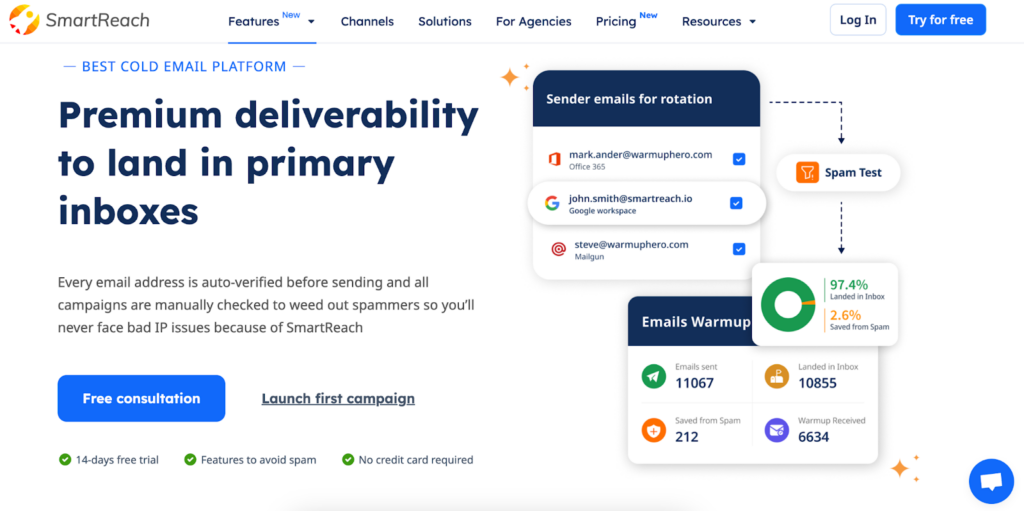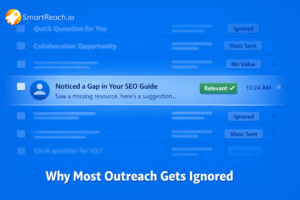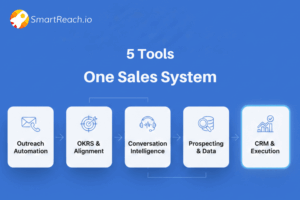How can I avoid spammy words to prevent my emails from going to spam?
You line up your best pitch, hit send… and then? Silence.
No opens. No replies. Just your email, sitting unnoticed or worse, flagged as spam.
Nearly 20% of legitimate business emails never make it to the inbox (2024 Email Deliverability Benchmark Report, Return Path).
And for cold email outreach?
That number climbs even higher.
For sales teams, every email in spam equals lost revenue and wasted effort.
This guide will show you exactly why your emails are getting flagged and give you a proven, step-by-step plan to make sure your next send lands where it should: the inbox.
Why sales emails go to spam (and how to fix it)?
Email providers don’t just scan for words like “free” or “guarantee.”
They track sender reputation, as well.
Every ignored, deleted, or marked-as-spam email hurts that score.
- Key reason: Bad lists, poor engagement, and no authentication kill email deliverability. Just a few spam complaints can also damage your reputation for months.
How to build your sender reputation?
- Ditch purchased lists. Cold emailing strangers? That’s how you rack up spam complaints fast.
- Warm up new accounts. Start slow (10-20 emails/day) and scale up gradually to build trust.
- Pick the right platform. Use Google Workspace, Outlook, or tools like SmartReach.io not free Gmail or shared IP services that tie your reputation to others.
Fix your technical foundation
- Set up SPF, DKIM, DMARC. These prove you’re legit. Without them, your emails look suspicious, no matter how good the content.
- Automate it with platforms like SmartReach.io that handle authentication and warmup, so you don’t have to stress about the technical setup.
Recommended Read: How to Improve Your Sender Reputation for Better Cold Email Deliverability?

How to write non-spammy content for your email outreach?
Once your foundation is solid, focus on creating content that email spam filters and prospects both appreciate.
#1 Subject lines that avoid the spam folder
Your email subject line is the first thing filters evaluate. Skip the sales-y language and focus on clarity.
Instead of “URGENT: Limited time offer inside!” try “Quick question about [specific company initiative].”
Avoid these common mistakes:
- ALL CAPS (looks like shouting)
- Multiple exclamation points
- Symbols like $ or % in promotional contexts
- Generic phrases like “touching base” or “following up”
The best sales subject lines are specific and relevant to the recipient.
Reference something from their company, industry, or recent news to show you’ve done your homework.
Read more: How to Write Effective and Spam-Proof Email Subject Lines
#2 Balance your text and images
Email filters get suspicious when messages are mostly images.
Aim for 80% text and 20% images maximum.
If you include images, always add alt text. This helps accessibility and gives filters context about your content.
Compress images to keep file sizes small; large attachments can trigger spam flags.
Never send image-only emails. Always include meaningful text that provides value, even if images don’t load.
#3 Personalize without sounding robotic
Generic emails don’t just turn off prospects, they also tip off spam filters that you’re blasting the same message to everyone. Real personalization goes way beyond dropping someone’s name.
Call out something specific about their company, their role, or something they’ve recently done.
Tools like LinkedIn Sales Navigator make it easy to find these details.
And keep it human. Write like you’re talking to a colleague, not like you’re giving a formal presentation.
Pro tip: read your email out loud. If it sounds stiff, rewrite it.
#4 Limit your links and avoid redirects
Too many links make your email look promotional. Stick to 1-2 relevant links per message. Using the right number of links helps with better deliverability.
Never use link shorteners like bit.ly in sales emails. They hide the destination and trigger spam filters. Use full URLs or branded short domains instead.
Make sure all links work before sending. Broken links hurt your credibility and can affect deliverability.
Build and maintain a healthy email list
Your email list quality directly impacts your deliverability.
A clean, engaged list will always outperform a large, unengaged one.
Let me consolidate the key strategies for effective list management.
Here’s how to do it –
#1 Build your list the right way
Never buy email lists. Period.
Purchased lists are full of spam traps, inactive addresses, and people who never consented to receive your emails.
Instead, build your list organically through:
- Website opt-ins
- Content downloads
- Webinar registrations
- Trade show contacts who explicitly agreed to follow up
Use double opt-in when possible. This confirms people actually want to hear from you and weeds out fake or mistyped email addresses.
Read more: How to build a business email list
#2 Clean your list regularly and handle unsubscribes professionally
- Remove hard bounces (bad emails) immediately; they tank your sender reputation.
- Cut out unengaged contacts. If someone hasn’t opened your emails in 6+ months, it’s time to either re-engage or remove.
- Re-engage before removing. A fresh subject line or offer might bring them back.
- Make unsubscribing easy and process it fast. Don’t send a final “sorry to see you go” unless they asked for it.
Build trust with prospects and email providers
Trust is the foundation of good deliverability.
Both email providers and prospects need to see you as legitimate and valuable.
#1 Keep your branding consistent
Use the same sender name and email address for all your outreach. Switching between different addresses confuses recipients and can trigger spam filters.
Include your company information and a professional email signature. This builds credibility and shows you’re a real person, not an automated system.
#2 Provide real value in every email
Don’t just pitch your product in every message. Share industry insights, helpful resources, or relevant news that benefits your prospects regardless of whether they buy from you.
This approach reduces spam complaints because people actually want to receive your emails. It also improves your response rates because prospects see you as a valuable resource.
#3 Respect communication preferences
Pay attention to how prospects prefer to communicate. If someone asks you to call instead of email, respect that preference.
When prospects don’t respond after several attempts, give them space. Continuing to email unresponsive prospects hurts your reputation and wastes your time.
Advanced emailing strategies for scaling sales teams
If you’re managing a sales team or scaling your outreach, these advanced tactics will help maintain deliverability across multiple senders.
#1 Distribute outreach across team members
Don’t have one person send all your cold emails.
Distribute your prospect list across multiple team members to avoid overwhelming any single sender’s reputation.
Each team member should build their own sender reputation gradually.
This also creates redundancy; if one person’s deliverability drops, others can continue outreach.
#2 Create email sending schedules
Coordinate your team’s sending times to avoid clustering all emails at once. Spread emails throughout business hours across different time zones.
Create a team calendar for major campaigns. If everyone sends emails simultaneously, you might trigger spam filters that detect coordinated sending patterns.
#3 Monitor team-wide metrics
Track deliverability metrics across your entire team, not just individual performance.
One team member’s poor practices can sometimes affect the whole domain’s reputation.
Set up alerts for when bounce rates or spam complaints spike. Address issues quickly before they spread to other team members.
How SmartReach.io solves email deliverability challenges comprehensively
At the end of the day, improving deliverability isn’t about tricking spam filters — it’s about combining smart strategy, technical best practices, and tools that do the heavy lifting for you.
SmartReach.io’s email deliverability suite is designed to tackle the root causes of spam placement.

With features like WarmupHero, your sending volume scales gradually, building trust with email providers as your messages consistently earn opens and replies.
The inbox rotation capability helps distribute your emails across multiple verified accounts, protecting your sender reputation by avoiding the red flags of high-volume sending from a single address.
SmartReach.io goes a step further with ESP matching technology, aligning your sends with your prospect’s email provider to create natural, trusted sending patterns.
The platform’s built-in email verification ensures you’re targeting valid addresses, reducing bounce rates and protecting your domain’s health.

On top of that, spam testing and global blacklist monitoring keep constant watch on your setup; flagging risks, pausing dangerous sends, and giving you peace of mind that your outreach stays compliant and effective.
When you combine genuine, value-driven communication with the right tools, your emails will land where they belong in the inbox, ready to drive real conversations.
Start your free 14-day trial of SmartReach.io and experience the difference for yourself.
Frequently asked questions about email deliverability
What percentage of sales emails go to spam?
Studies show that approximately 20% of legitimate business emails end up in spam folders, with cold sales emails facing even higher spam placement rates due to lower engagement and sender reputation factors.
How long does it take to fix email deliverability issues?
Basic authentication and technical fixes can improve deliverability within 1-2 weeks, while full sender reputation recovery typically takes 4-8 weeks of consistent good practices and engagement monitoring.
What is the most important factor for email deliverability?
Sender reputation is the most critical factor, determined by recipient engagement, authentication setup, and complaint rates rather than just avoiding spam trigger words.
Can I recover from having my emails marked as spam?
Yes, but recovery requires patience and systematic improvement. Reduce sending volume temporarily, focus on highly engaged contacts, fix authentication issues, and gradually rebuild your reputation over 4-8 weeks.
Should I use a different domain for cold outreach?
Large sales teams sometimes use separate domains for different types of outreach—one for warm leads, another for cold prospecting. This prevents issues with cold outreach from affecting your warm prospect communications.
How to make sure your emails don’t go to spam?
To prevent emails from going to spam, set up proper authentication (SPF, DKIM, DMARC), maintain a clean email list, personalize your content, avoid spam trigger words, build sender reputation gradually, and monitor engagement metrics regularly.
What words to avoid for spam filter?
Avoid words like “free,” “urgent,” “guaranteed,” “act now,” “limited time,” “make money,” “no obligation,” “cash,” “winner,” and excessive punctuation. Focus on clear, professional language that provides genuine value to recipients.
How to block spam emails with certain words?
Most email clients allow you to create filters based on specific words or phrases. Go to your email settings, create a new filter, specify the words you want to block, and set the action to move these emails to spam or delete them automatically.
What are 5 negative words to be avoided in emails?
The top 5 words to avoid in sales emails are: “free” (unless genuinely offering something), “urgent” (creates false pressure), “guaranteed” (sounds too promotional), “limited time” (appears pushy), and “act now” (triggers spam filters).
How do I get my emails to stop going to spam?
Stop emails from going to spam by authenticating your domain, warming up new email accounts, cleaning your contact list regularly, writing natural subject lines, personalizing content, maintaining consistent sending patterns, and monitoring deliverability metrics.
What words trigger spam filters?
Common spam trigger words include promotional terms like “buy now,” “discount,” “offer expires,” financial terms like “credit,” “loan,” “investment,” and urgency words like “immediate,” “instant,” “hurry.” Use these sparingly and in appropriate context.
How to avoid spammy content?
Create valuable, relevant content by personalizing messages, using professional language, maintaining proper text-to-image ratios, limiting links, avoiding ALL CAPS, providing clear unsubscribe options, and focusing on recipient benefits rather than sales pitches.
What are spammy words?
Spammy words are terms commonly used in unwanted promotional emails, including “amazing deal,” “risk-free,” “call now,” “easy money,” “get paid,” “home-based,” “income guaranteed,” “order now,” “save big,” and “special promotion.”
How do I prevent spam in my email?
Prevent receiving spam by never responding to suspicious emails, avoiding posting your email publicly, using email filters, enabling two-factor authentication, keeping your email client updated, and reporting spam to help improve filtering systems.
How to totally block spam emails?
Completely block spam by using robust email filters, enabling advanced spam protection features, creating custom rules for suspicious patterns, using separate email addresses for different purposes, regularly updating your spam filter settings, and considering third-party anti-spam solutions.




